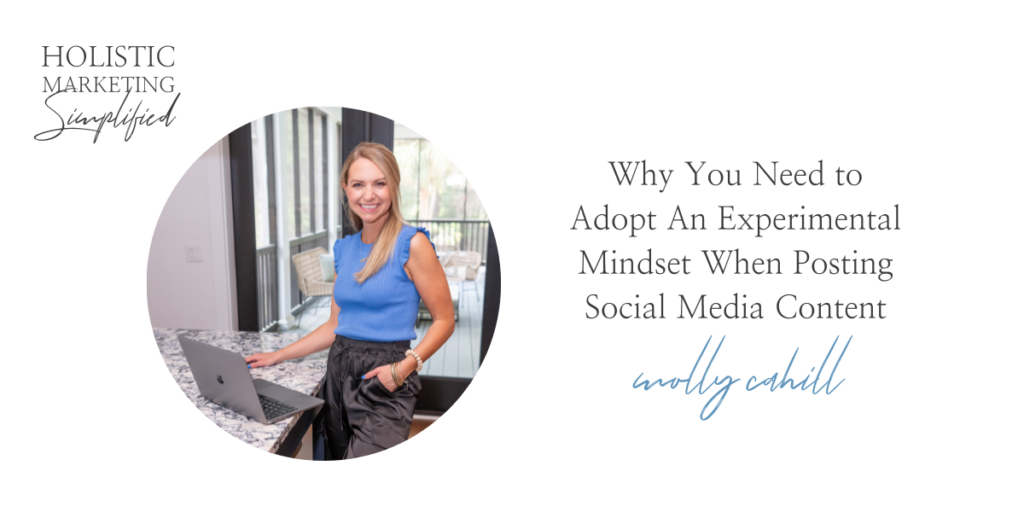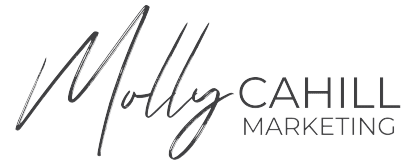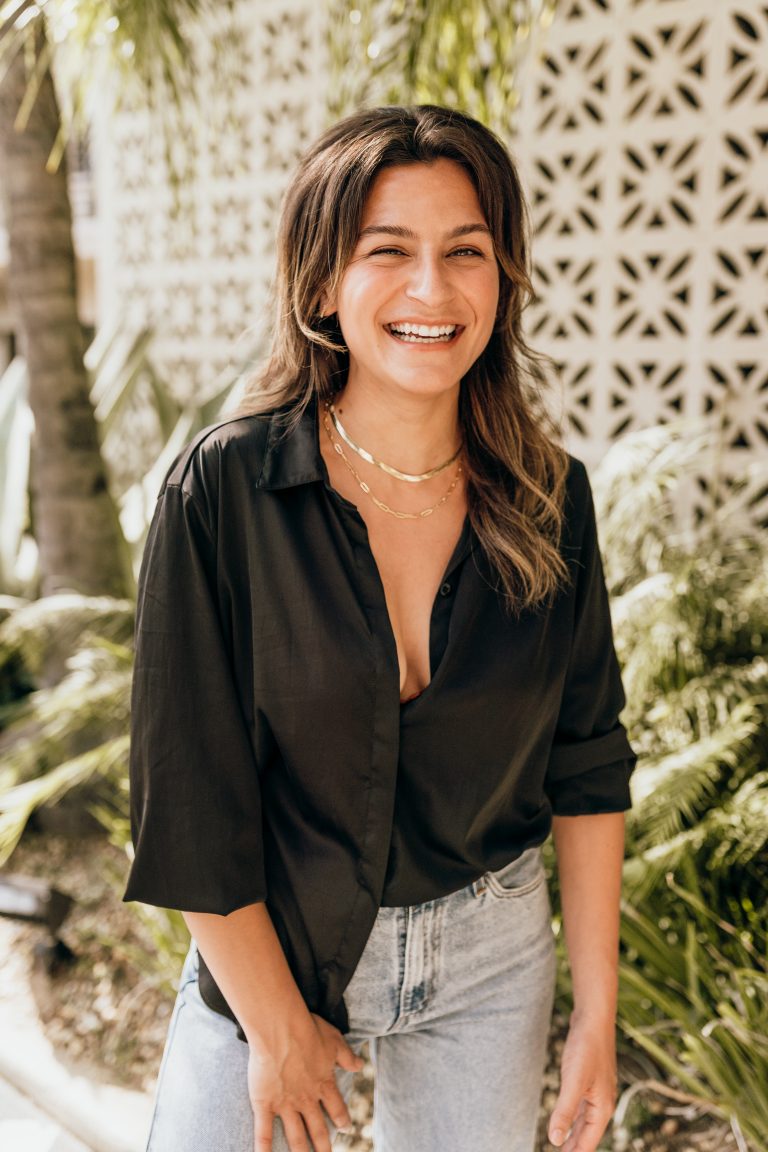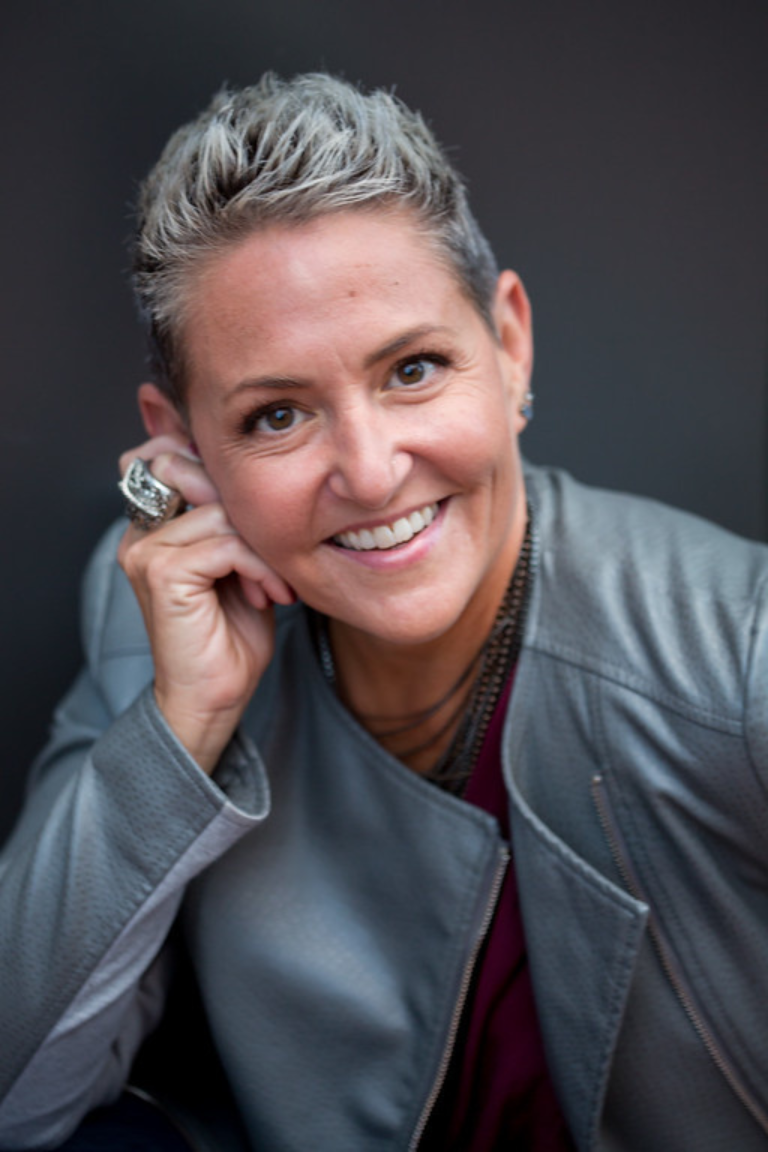Episode 85: Why You Need to Adopt An Experimental Mindset When Posting Social Media Content

Subscribe on Your Favorite Podcast Player
Apple Podcast App | Spotify | Stitcher | Google Podcast
It feels like everyone lately has been taking their social media content so seriously. Everyone from the Holistic Marketing Hub students to followers popping into my DMs have been talking to me about how much pressure they feel to create a singular carousel post or reel.
I want to challenge you to take a step back, let go of your expectations, and develop an experimental mindset when it comes to content creation.
And today I’m sharing all about why this mindset shift is necessary and how it will help you improve your social media content. Let’s get into it!
Stop obsessing over the details
I recently had a Holistic Marketing Hub student share a really cool story with me about one of her patients. Her patient, a postpartum mom, had developed Bell’s Palsy and she was able to help her heal.
I was immediately on content alert and told her she definitely needed to share this case study!
I suggested she choose a format she and the patient were most comfortable with for sharing, but after a few weeks, she still hadn’t posted anything.
When I followed up with her, she told me – “I just can’t get it quite right!”
Now that example sticks out to me because the patient story was seriously so impressive, but this scenario happens to the chiropractors and wellness practitioners I work with all the time.
Social media content just isn’t that big of a deal.
Sure, if you post something on your grid it will stay there unless you delete it… but at its core, social media content is fleeting!
If getting things perfect or waiting to create just the right post is holding you back from putting content out there – you’re doing social media wrong.
And there’s a mindset shift that will change everything for you!
The power of an experimental mindset
When you adopt an experimental mindset around your social media, you’ll immediately move from “Is this good enough?” to “Ohh let’s try this out!”
It’s a huge breath of fresh air.
With the Bell’s Palsy patient example I just shared, an experimental mindset would look like jumping on stories and talking about it.
I love recording videos in my car (not driving – don’t do that!) because the lighting is usually good, it’s quiet, and no one can see me.
So I would pull out my phone and act like I was FaceTiming a friend to tell her about this incredible experience I just had with my patient. That can be your “first draft” that disappears after 24 hours and is super low stakes.
Then once you’ve chatted about it on stories, maybe you want to turn it into a carousel post case study and then create a reel talking about the patient’s experience and outcomes in a face-to-camera reel.
By the time you create the reel, you’ve talked about this case a number of times and it should feel comfortable and more natural.
When you prioritize experimenting, you end up with 3-4 content pieces about the same topic. Now you can see which one resonates with your audience, see where you get the most engagement, and just kind of have fun playing around with it!
Repeated posts
When it comes to a specific topic, patient example, or education – so many people have it in their minds that you can only talk about it one time.
It’s like everyone feels like Hilary Duff in Lizzie McGuire when the school bully accuses her of being an outfit repeater!
Except here’s the truth… no one even notices if you repost things.
People need to see things seven times (or 21 -75 times depending on what study you read) in order to take action, so you’re not going to wear out a topic by posting about it once!
Let’s say you introduce a new red light therapy service. You write one post about it and talk about it on stories… and then you wonder why no one has booked the service a few weeks later.
They don’t know about it.
Like my friend Mia (@campaign_del_mar on Instagram) says:
“Marketing is saying the same thing 100 times, not saying 100 things once.”
With our in-house content clients, we regularly repost things exactly as they are or with a small tweak to freshen them up every 90 days.
Adopting an experimental mindset means getting over your fear of being a topic repeater and posting what’s resonating with your audience over and over… and over.
An experimental mindset lets you discover what your people like
You can’t determine what resonates with your audience without giving them a lot of different options.
When it comes to social media, I recommend looking at more than likes and views to judge your engagement.
You can also track how many people comment, how many people reached out based on a post, if it generated any new content, or how many people shared it.
We want content that is going to bring you new patients. So even if something doesn’t have great metrics, if it brought people through the door – that’s the type of content we want to create more of.
If you’re not sure how to create different types of content in order to find out what resonates with your audience, you need to download my Content Ecosystem. It breaks it all down for you and lays out my signature approach to social media marketing!
What’s next?
If you’re excited to try an experimental mindset with your content, I hope you’ll pop into my DMs so we can jam out about what’s working and how to take the pressure off!
Remember – social media marketing is a great way to bring new patients into your audience and show them how you can help them.
This isn’t that serious… but it can be a game-changer for your practice!
Stop aiming for perfection, put stuff out there, and have fun experimenting with your content.
Connect with Molly
Instagram | Facebook | Youtube
The Holistic Marketing Simplified Podcast is brought to you by Holistic Marketing Hub, our hybrid program that supports you with personalized coaching, caption templates, and virtual classrooms. In this program, we teach health and wellness professionals how to fish, but also bait their hook!
Make sure you’ve hit that follow or subscribe button on on your favorite podcast player to get notified each week as we air new episodes!
Hi, and welcome back. This is going to be another short episode. And today, this is just something I've been seeing so much lately, not just with hub students, but just across the board with DMs I'm getting from people. And it is. It's all about changing your mindset around your posting from a like, I am creating the Mona Lisa piece de resistance that's going to hang above my mantle for eons to come.
I feel like that's kind of like the mindset that many people are approaching a singular real a singular carousel a singular post with when really you should just be approaching it from. Yeah. An experimental mindset. And I want to dive into that today. So here we go. Hey,
welcome to Holistic Marketing Simplified. This podcast boils down to the fact that we wholeheartedly believe that more humans need to know about holistic health solutions. And you didn't go to school to learn how to be a holistic. Full-time content creator and show up on Instagram and do all of this marketing stuff all day, every day.
So let's come hanging out while we chat. All things easy in your marketing and my goal is that you shift your mindset around your marketing from a quote should to a I get to more dream patients and clients. Yes, please. Hi, I'm Dr. Amy Forrester and I'm a chiropractor in Kenosha, Wisconsin. And I listen to the Holistic Marketing Simplified podcast.
This came about because, well, I'll, I'll give you one specific example. I have a lovely. Holistic Marketing had a student who had the coolest case study of a postpartum mom who developed Bell's Palsy and then through care with her, she was able to help this person's Bell's Palsy. And I was like, wow, that's such an amazing story.
You definitely need to talk about that. So of course, the next question is, well, how? And I'm like, well, however you feel the most comfortable. Do you want to type it up and put it in a carousel? Do you want to just like talk about it in stories? Do you want to, you know, post a reel about it? Do you have before and after pictures?
Is she comfortable with that? And a couple weeks went by and I followed up with this student about it and she still hadn't posted anything because she said she just couldn't quite get it right. If you're listening to this, you know who I'm, you know who you are. I'm not calling, but this is, this happens across the board all the time.
You are not alone. Your just specific example stood out to me because it was such a cool story. I have so many who just worry and obsess over every little detail and, and, and the logistics of how they're going to get this post out, that it made me realize that many of you are approaching this. And I said this in the intro from this lens that like, this is it.
You're creating this piece of content and everyone's going to see it and everyone's going to judge you and it is out there and it is going to live on forever. And that is just not how social media content creation works. Everything that goes up on your feed, yes, it lives there forever unless you go delete it.
But content is so fleeting. So I'm going to talk about a couple different ways that this comes into play. So like I said in the intro, I talked about how I really want you to adopt more of an experimental mindset, so let's take that same Bell's Palsy case study. If it were me, if I had this, I would post about it.
I would just get on Stories, sit in my car, not driving. I don't, don't, I don't think you should film while you're driving. I think that's just a recipe for disaster. But car lighting is great, nobody can see you, sound is good in the car, and I would just start talking about it. It doesn't have to be clean or polished, you don't have to worry about ums or likes or pauses or anything like that.
Just pretend like you're FaceTiming a friend. And that's kind of like your first draft of talking about this. Then once you're a little more comfortable talking about it, then maybe you can replay Instagram story where you just kind of rift off the cuff talking about this case study. And maybe you want to type out some of your key thoughts and put it into, let's just say a case study carousel on Canva, where on the front slide, you're talking about this person in there.
Maybe if they are okay having a before and after picture, but if not, even it's totally fine. Or you would put something like postpartum Bell's palsy. And then you would, through each slide, explain, you know, you know, the patient came in with this and then this is what we did and then now here is her outcome.
And then once you've got your thoughts a little more organized that way, I would, you know, post that reel, I mean that carousel, and then I would post it again as a face to camera reel talking about it because now you've got your points a little more succinct in carousel form, like you could almost like use the carousel as a way to.
You know, read off your thoughts. And then, I would post about it a fourth way, using more of a b roll type reel with a hook over the reel screen that's like how I helped my postpartum patient with her Bell's palsy or something that's like chiropractic spans way beyond pain management. Here's how I helped my postpartum patient with Bell's palsy.
And then you would use the same, same exact caption from when you posted the carousel for that reel. So do you see how that's like a way different way of thinking about it than like, okay, I've got to get this one post. All of my chips are on this one. Post as if I always joke, it's like you're creating some legacy piece of art that's going to hang above your mantle forever.
And you know, you always have the flexibility of deleting something if you want to. I don't really encourage that because promise you way fewer people are paying attention than you think are paying attention. The people who are going to be crazy, crazy nitpicky and be like, Hey, um, you spelled Tuesday wrong.
are probably not the type of people you want as clients or patients. I don't know, maybe it is. For me, I, I don't because I just, yeah, I believe in taking messy action, but that's just kind of like my, my MO. And this just plays back into something I've talked about a lot on my Instagram and on the podcast and in my emails that most people are not talking about things enough.
You post something one time. And then you were like, okay, I can't post about it again because I'd already posted about it. And again, I just want to remind you, that's just not how it works when it comes to social media content. And we've even had clients at our Instagram management agency before be like, well, I posted that, you know, 44 weeks ago.
And I'm like, well, Okay, we've gained new followers since then and I highly doubt the people from 44 weeks ago are going to, you know what I mean? Like you've got to, actually let me find this quote from my friend Mia because it is so good about marketing. It like really brings home this point about how So it used to be called the marketing rule of seven where they said people need to see things seven times in order to take action.
So let's say you get a new sauna, red light therapy, whatever in your office and you want to post about it. So you post about it once and then you're like wondering why no one has now taken you up on this new service. But you need to post about it again and again and again and again and again. And like I said, it used to be called the marketing rule of seven, but I was Googling that when I was updating some curriculum for Holistic Marketing Hub recently.
And I found one article that said it's actually now 21 times. Then I found another article that said it's 75 times that people need to see something in order to take action simply because we are inundated with so much more content than we used to be. Bye. Bye. I found the post from my friend Mia, and her handle on Instagram is campaign Dell Mar campaign.
Delmar Marketing is saying the same thing 100 times, not saying 100 things once. And when she posted that, I was like, yes. I swear to you, I'm not the only. Like I shared it to my stories and I'm like, guys, I know y'all are sick of me saying these things, but truly, I mean, there's a reason when we go to plan out our Instagram management client's content for the month, one of the first things we look at is what has performed the best over the last 90 days and how can we either just repost it as is or.
Or how can we put like a small spin on it to make it slightly fresh, but be basically like the same piece of content. So an example for my own feed is I posted the caption. I didn't change anything. And when I'm saying caption, I'm talking about not the text that's on the video. I'm talking about, like, the actual caption, like, underneath the reel.
I posted the same exact caption for two different reels. I used two different b roll videos, but One of the b roll videos was me popping a bottle of champagne. It says, when you stop using stock photos on Instagram and post short video clips of you working with patients instead. And then I just did like a small footer that was like, how to fit filming into your busy schedule.
So that was on August 16th, I posted that one. And then on August 23rd, so only one week apart, I posted the exact same thing, except with a different B roll video. And the text I put over the screen was, how to film video for Instagram Reels when your schedule is back to back patients. So like I said, the caption is the exact same, but I just tweaked the video and I tweaked the text that was over the video slightly.
So this is why I'm able to pump out content so quickly, is because I am not afraid to say the same thing over and over and over again, because, and, and I will say, like, for those of you who are just starting out, it is more of a, you know, maybe saying a hundred different things just because you're trying to kind of figure out what lands with your audience.
But at this point, I know what's landing with my audience. So let me actually, I'm going to do this live with you on the podcast because I haven't looked at this yet. So, variation two of the same reel I posted four days ago, let me look at my insights on that one. Um, I reached 11, 000 accounts, 86 percent of them were non followers, that's huge, but yeah, I didn't really, I got a few saves and shares, but I didn't get any profile activity, meaning like no one came back to look at my profile, no one followed me from it.
And I didn't get any email opt ins from that version. The Champagne version, I got two email opt ins. So, this is so funny, I only reached 1, 900 accounts, and it was about 50 50 with followers to non followers. Um, and it still didn't get a ton of profile activity, but it got more saves and shares. So I mean, that honestly doesn't tell me a whole ton.
It's just, I kind of like to, it's just interesting to me, like I said, to kind of have this experimental mindset when toying around with the same message over and over. One thing that is consistently performed, or there's actually two, two things that I messages that have consistently performed well for me.
And one is about only posting educational content on your Instagram. Anytime I post a reel with that, I use the same exact, same exact caption about my content ecosystem. Holy cow, this last one did really, really, really well. I only reached a thousand people, but I got a ton of email opt ins from it. So that's why I don't like people to just look at your views because there's so many other metrics too.
And if you're wondering how I'm, how I know I got email opt ins, it's just about who, who commented the trigger word to my mini chat automation. The last time I posted, almost exact same hook, almost exact same reel, same, okay. I got a couple follows and profile, only 1100 reach, but again, I got a lot of email opt ins.
So yes, you know, all of this is still, like I said, going back to this experimental mindset, just throw something up. It's totally like everybody poopoo's throwing spaghetti at the wall to see what sticks. But when you're in the beginning. I don't think it's that bad of an idea just to kind of see what messages are resonating the most with your audience.
And don't just base it on views, you know, look at your other behind the scenes metrics as well. And if you're a hub student, you have like a full class that dives into all of the metrics. But Once you have kind of seen, okay, I know anytime I post this, so let me give me an example. Dr. Lauren from She Slays, um, we were recently, we run her Blue Hills, Cairo, Instagram account.
Do not go follow them. You can go look at the account, but please don't follow them. And if you are following, please unfollow because we're trying to fix her. follower location. When we were reviewing her top performing content in terms of views and shares, she pointed out that there was a Tordicallis carousel that did not fall in any of the top reached content when we were sorting by top content, like top performing.
Um, sorting by top content reach, reach, you know what I'm trying to say, we were sorting her content that has reached the most people. This carousel was not even remotely in some of the top content, but she said that that carousel specifically had people calling to become a new person. patient. So like I said, you've got to look at all of the different factors.
And while if you've been following me for a long time, you know that I don't teach just, you're going to be like, Molly, you just said this and now you're contradicting yourself. But I don't teach that a content strategy is just to only repost what has performed well. Because there's a reason for this. I teach what's called a content ecosystem.
You can download that. I will link it in my show notes, or you can just DM me the word ecosystem. And that'll, um, trigger my automatic automation to get that to you. But if you only repost your top performing content, typically, That, and what I'm saying top performing, I mean, top performing in terms of like views, reach, things like that, things you can see on Instagram, not top performing as in what Dr.
Lauren said, the torticollis carousel, right? Because that is the stuff we want. We're like, that's what actually brought her new patients. So we reposted the torticollis carousel for her. And then we made a real version of it as well with a B roll video with the same caption. We're just going to, I'm curious to see which does better.
Anyway, what I'm saying, if you're just strictly looking at your statistics on Instagram, a lot of marketers will say, well, just look at what's performing best and just repost more of that. That's not bad advice. Like I said, that's, that's what we do to inform some of the posts that go in our clients next month of content, but not all.
And the reason for that is if you want to go back, um, I talk about awareness levels in one of my past podcast episodes, we'll link that in the show notes. Typically the stuff that's like sexier, more viral, that's your more top of funner, funner, oh my gosh, you can tell it's the end of the day, top of funnel, colder leads.
So that's the stuff that casts a wide net to bring people into your sphere. And then you're more like, Face to camera talking videos, or like I said, these more like meatier carousels that aren't as sexy when it comes to like views necessarily. But that's typically the type of content that's going to actually make them book an appointment.
So do you see the distinction there why I say yes, you want some, you know, more of that? Top of funnel wide net casting content to bring more people into your sphere. But then you also still need the stuff that doesn't quote perform as well. Um, on paper to, you know, establish you as the authority and bring it home.
I guess the main point of today is just, I encourage you to adopt an experimental mindset rather than thinking of each piece of content being. the piece of content where you're talking about X. So like, let's say, um, I just had a hub student ask me the best way to promote their care plans. So of course, the first thing I told her is like, well, we're not just going to do this in one post, right?
Since care plans are like a key pillar of your practice, we're going to talk about care plans in your content every week. So it's not like, what is the post to promote care plans? It's like, How do we incorporate this over and over and over and the same thing with these really cool case studies, um, or, or anything you do in your, in your business.
All right. I would love to jam with you in my DMs if this was helpful or anywhere that I can clarify for you. I would love to do so. Have a great day. Thank you for listening to Holistic Marketing Simplified, and hey, you know how every podcaster at the very end of their episode asks you You to rate and review their podcast?
Well, that's because it's super important. These podcasts take a lot of time and heart and effort to produce, to bring you free information. So in order for me to be able to continue doing that, we need more people to find out about the show. So if you could please just take like two minutes out of your very busy day to leave me a rating and share this on your Instagram stories and tag at Molly a Cahill.
That's. C A H I L L. I would greatly, greatly appreciate your support. I know your time is valuable and I can't wait to see you in the next episode.

![How to Hire a Virtual Assistant and Get the Support You Need [Episode 112]](https://mollycahill.com/wp-content/uploads/2025/03/How-to-Hire-a-Virtual-Assistant-and-Get-the-Support-You-Need-Ep-112.png)

![Social Media Strategy for Offices with Multiple Providers [Episode 106]](https://mollycahill.com/wp-content/uploads/2025/02/Social-Media-Strategy-for-Offices-with-Multiple-Providers.png)


